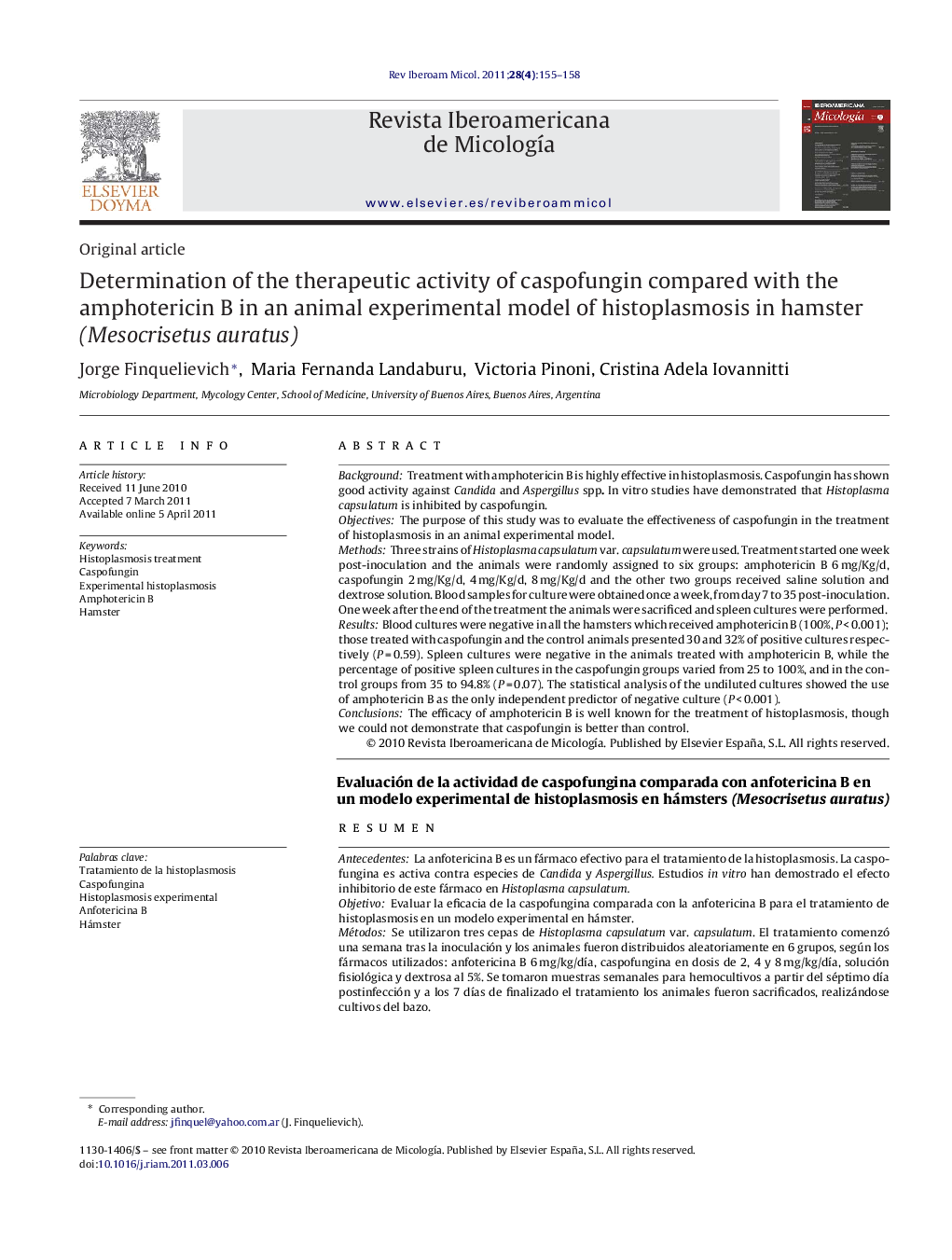| کد مقاله | کد نشریه | سال انتشار | مقاله انگلیسی | نسخه تمام متن |
|---|---|---|---|---|
| 3418911 | 1225786 | 2011 | 4 صفحه PDF | دانلود رایگان |

BackgroundTreatment with amphotericin B is highly effective in histoplasmosis. Caspofungin has shown good activity against Candida and Aspergillus spp. In vitro studies have demonstrated that Histoplasma capsulatum is inhibited by caspofungin.ObjectivesThe purpose of this study was to evaluate the effectiveness of caspofungin in the treatment of histoplasmosis in an animal experimental model.MethodsThree strains of Histoplasma capsulatum var. capsulatum were used. Treatment started one week post-inoculation and the animals were randomly assigned to six groups: amphotericin B 6 mg/Kg/d, caspofungin 2 mg/Kg/d, 4 mg/Kg/d, 8 mg/Kg/d and the other two groups received saline solution and dextrose solution. Blood samples for culture were obtained once a week, from day 7 to 35 post-inoculation. One week after the end of the treatment the animals were sacrificed and spleen cultures were performed.ResultsBlood cultures were negative in all the hamsters which received amphotericin B (100%, P < 0.001); those treated with caspofungin and the control animals presented 30 and 32% of positive cultures respectively (P = 0.59). Spleen cultures were negative in the animals treated with amphotericin B, while the percentage of positive spleen cultures in the caspofungin groups varied from 25 to 100%, and in the control groups from 35 to 94.8% (P = 0.07). The statistical analysis of the undiluted cultures showed the use of amphotericin B as the only independent predictor of negative culture (P < 0.001).ConclusionsThe efficacy of amphotericin B is well known for the treatment of histoplasmosis, though we could not demonstrate that caspofungin is better than control.
ResumenAntecedentesLa anfotericina B es un fármaco efectivo para el tratamiento de la histoplasmosis. La caspofungina es activa contra especies de Candida y Aspergillus. Estudios in vitro han demostrado el efecto inhibitorio de este fármaco en Histoplasma capsulatum.ObjetivoEvaluar la eficacia de la caspofungina comparada con la anfotericina B para el tratamiento de histoplasmosis en un modelo experimental en hámster.MétodosSe utilizaron tres cepas de Histoplasma capsulatum var. capsulatum. El tratamiento comenzó una semana tras la inoculación y los animales fueron distribuidos aleatoriamente en 6 grupos, según los fármacos utilizados: anfotericina B 6 mg/kg/día, caspofungina en dosis de 2, 4 y 8 mg/kg/día, solución fisiológica y dextrosa al 5%. Se tomaron muestras semanales para hemocultivos a partir del séptimo día postinfección y a los 7 días de finalizado el tratamiento los animales fueron sacrificados, realizándose cultivos del bazo.ResultadosLos resultados obtenidos de los hemocultivos realizados al finalizar el tratamiento fueron negativos en un 100% en el grupo tratado con anfotericina B, frente al 30% en el grupo tratado con caspofungina y el 32% en el grupo control (p = 0,59). Los cultivos de bazo fueron negativos en el grupo de anfotericina B, mientras que en el grupo de caspofungina los valores fluctuaron entre el 25 y el 100%, y en el grupo control entre el 35 y el 94,8% (p = 0,07). En el análisis estadístico del cultivo de la suspensión de bazo sin diluir el uso de anfotericina B fue el único predictor independiente de cultivos negativos (p = 0,001).ConclusionesLa anfotericina B es un fármaco efectivo para el tratamiento de la histoplasmosis. La administración de caspofungina no demostró mayor eficacia en comparación con el grupo control.
Journal: Revista Iberoamericana de Micología - Volume 28, Issue 4, October–December 2011, Pages 155–158